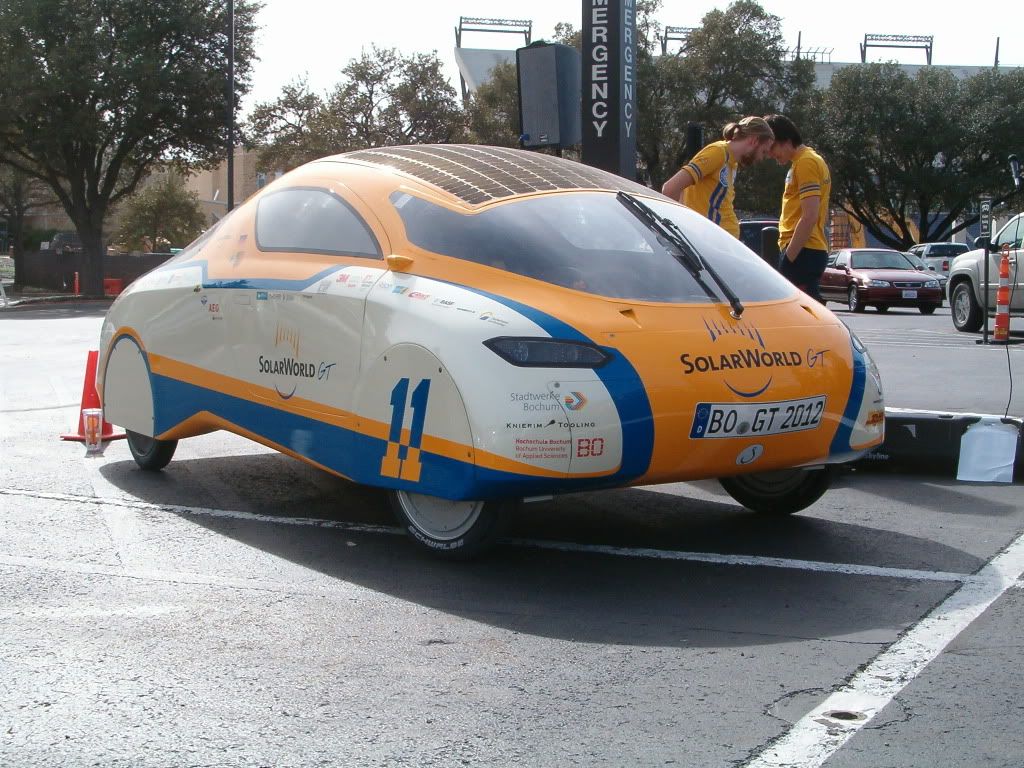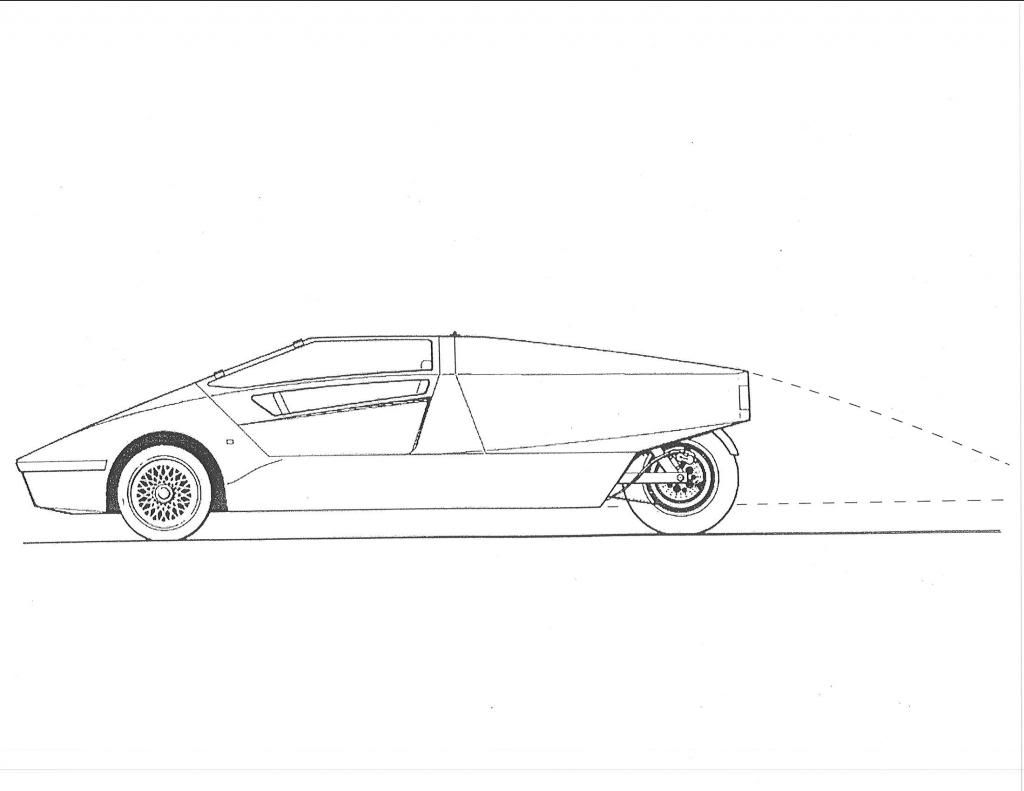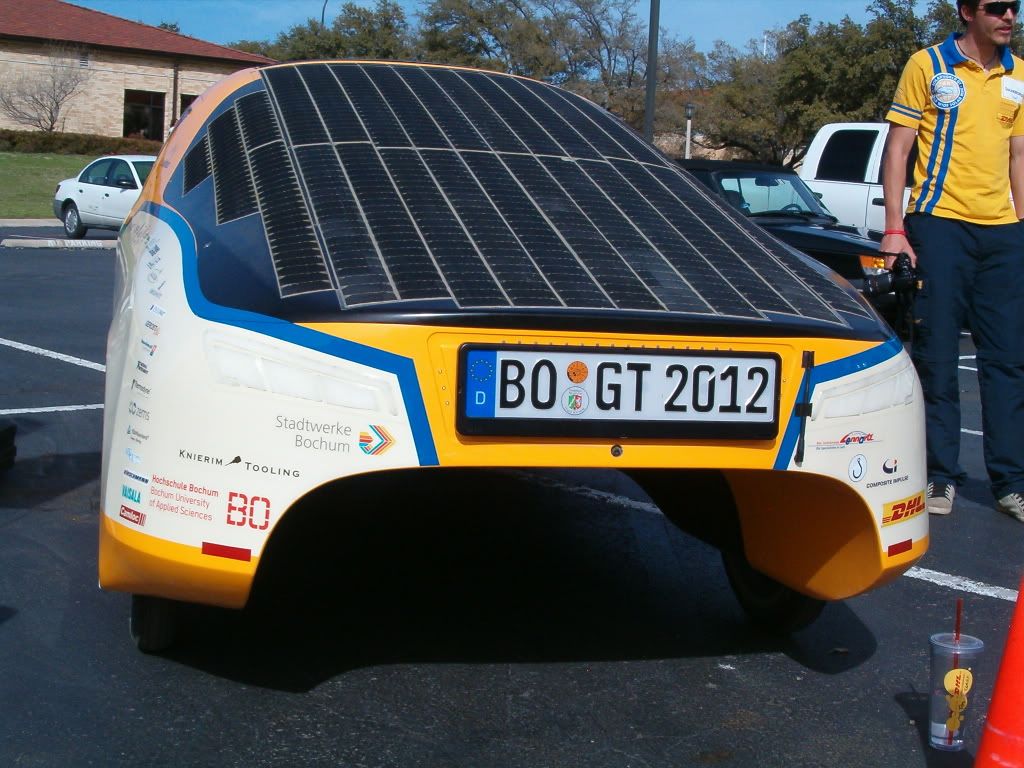 07-31-2014, 09:17 AM
07-31-2014, 09:17 AM
|
#1 (permalink)
|
|
EcoModding Lurker
Join Date: Apr 2013
Location: Australia
Posts: 19
Thanks: 2
Thanked 7 Times in 6 Posts
|
Flat or Teardrop?
I have been planning an EV build for some time, but recently have been talking to an engineer about the possibility of building scratch built a Solar/EV as opposed to adapting an ICE vehicle.
The two options are a custom built spaceframe or welding a spaceframe to a VW chassis.
The VW option means I only need to comply with 1971 Regs (which in Australia is a godsend).
The car will have a reasonable battery pack and the solar panels will be more for range extension and charging when stationary, but I can easily fit 1.2kw worth of 24V panels on the area I'm thinking about.
The car will be a 2 seater (side by side) with aeroscreens and aero fairings behind the heads of the occupants (much easier than a sealed cabin which requires lots of heavy stuff to go with it.
The passenger opening will normally be sealed.
Aerodynamics is at the forefront of my mind, and I was wondering if It would be better to have a flat wing profile with a fairly horizontal top (like most EV racers) or have a Teardrop as per the 'ideal' profile and send all of the air over the car.

I'm worried that if I go for a slim wing profile, it may mean having wheel fairings that can be damaged and a chassis that would act like a diffuser.
Having the ideal teardrop shape is appealing but the curved 3D aspect required to make an efficient one was daunting me a bit as I have never used composites.
I got thinking of alternatives and recently spotted this -

If I cut the bottom off the truck scoop off just under the scallop and used it as the front body work and then extended the body back as per the template (with the solar panels on the 'tail' would it be close enough to the template ideal?
It would make life a bit easier.
|
|
|

|
 Today Today
|
|
|
|
 Other popular topics in this forum...
Other popular topics in this forum...
|
|
|
|
 07-31-2014, 09:50 AM
07-31-2014, 09:50 AM
|
#2 (permalink)
|
|
Master Novice
Join Date: Jan 2008
Location: SE USA - East Tennessee
Posts: 2,314
Thanks: 427
Thanked 616 Times in 450 Posts
|
I'm sure aerohead will be along to weigh in on this in short order; this is right up his street.
For my own part, I want to comment on the human factors.
The wing profile would mean you could cover the car, as time and money permit, with solar panels. It would become a de facto perpetual motion machine. You wouldn't need to plug it in very often. If your daily commute is fairly short, you might never plug it in except under unusual circumstances.
The wing profile places several demands on the user however. Seating would necessarily be cramped and likely relatively unadjustable. Getting in and out would be radically different from a conventional car and possibly a lot more time consuming. That may not sound like a big deal but just try spending an extra ten seconds - it doesn't sound like much, does it - struggling with a canopy in a pouring rain and a ten-year-old Falcon starts to look pretty good.
The wing profile doesn't rise into the viewing plane of most drivers. For lots of drivers if you aren't tall, you aren't there. Similarly if you aren't wide you also aren't there, to which many motorcyclists can painfully attest. People are creatures of habit, and are in the habit of looking for things that are more or less car shaped while driving. Things shaped like cars are to be avoided while driving, things that are shaped like pedestrians are to be avoided. Things outside of those two very basic silhouettes take just a tad more time to process, and in that time accidents happen. You might build a perfectly lovely wing shaped car based on completely conventional VW underpinnings, how could anyone ever fail to recognize that it's a car, of course it's a car I can see that standing here looking at it, but can you expect every Tom Dick and Sheila affixing her lashes on her morning coffee run to understand that in the quarter-second's attention she lavishes upon you and your not-conventional ride? Maybe not.
The teardrop is already more or less car shaped. Cars have been evolving toward the teardrop ideal for the last 20 years, some more quickly than others but it's definitely happening. The Prius is probably the purest representation of this form and has been on the roads now for a decade, no driver looks at Prius and fails to see a car. They might fail to notice it, but if they notice it they don't see something that isn't a car.
The teardrop gives you more height. If you're as tall as the Falcon in the next lane over, the inattentive Bruce in the gigantic GMC trying to change lanes will see you there and probably not merge all over you. Probably. Your roofline is just visible beyond the top of his fender, so maybe he has an inkling not to try the change just yet.
The teardrop gives you radically more volume within its shape. Volume = seats, space for heads not encased within nacelle canopies, more seats in the back, and doors shaped more or less like all the other doors on the road. That right there is great, it means you have a wide world of door hardware to choose from, hardware that's already been engineered to be sturdy and reliable and all you have to do is find the right stuff whose geometry is close to what you're building, and you're good to go.
__________________


Lead or follow. Either is fine.
|
|
|

|
 07-31-2014, 10:19 AM
07-31-2014, 10:19 AM
|
#3 (permalink)
|
|
Master EcoModder
Join Date: Jul 2011
Location: Ann Arbor, Michigan
Posts: 4,193
Thanks: 135
Thanked 2,815 Times in 1,976 Posts
|
Quote:
Originally Posted by mistareno

The VW option means I only need to comply with 1971 Regs (which in Australia is a godsend).
|
Lots of studies and talk on that platform done in this forum over the years.
I suggest you do a forum search.
It's one thing to just think about doing something, and another to actually do it.
The simple approach is often best if you don't make to make a lifetime long project out of it.
Do you want to be working on this project a year from now?
Do you still want to be working on this project five years from now?
How about 10-years from now?
__________________
George
Architect, Artist and Designer of Objects
2012 Infiniti G37X Coupe
1977 Porsche 911s Targa
1998 Chevy S-10 Pick-Up truck
1989 Scat II HP Hovercraft
You cannot sell aerodynamics in a can............
|
|
|

|
 07-31-2014, 07:04 PM
07-31-2014, 07:04 PM
|
#4 (permalink)
|
|
Master EcoModder
Join Date: Jan 2008
Location: Sanger,Texas,U.S.A.
Posts: 16,404
Thanks: 24,471
Thanked 7,410 Times in 4,800 Posts
|
solar EV
I'd recommend that you look at as many World Solar Challenge competitor cars as you can stand,and see if something strikes you and looks like you could mimic the fabrication.They're all going to be low drag,whether wing,or half-body in origin.
--------------------------------------------------------------------------
If you were going to try to use the VW chassis,you might be able to graft your sectioned truck fairing for the nose.It would save a lot in fabrication time.
This 2012 Bochum University SolarWorld GT is a nice and easy to live with 2-door coupe.You just walk up to it,open the door,get in and go;without requiring a 'crew' to get in and out.It's Cd 0.137.pretty sweet.

If you extend and soften the rear contour you could see Cd 0.10,like the 2013 Cambridge University's Eco Racer,CUER

-------------------------------------------------------------------------
For 'wing' type side-by-sides,you should find a bunch of examples from past WSC competitions.They would be easier to fabricate and they'd have less frontal area.
--------------------------------------------------------------------------
Plex or Lexan bubble windscreens may not pass legal requirement.You need to know.
This 'VORTEX',from the 1980s used flat laminated safety glass for its windscreen.It might be a 'default' design if push came to shove.

-------------------------------------------------------------------------
Fun project!!!!!!!!!!!!!!!!!
__________________
Photobucket album: http://s1271.photobucket.com/albums/jj622/aerohead2/
|
|
|

|
|
The Following User Says Thank You to aerohead For This Useful Post:
|
|
 07-31-2014, 07:17 PM
07-31-2014, 07:17 PM
|
#5 (permalink)
|
|
Moderator
Join Date: Feb 2012
Location: Urbana, IL
Posts: 1,939
Thanks: 199
Thanked 1,807 Times in 943 Posts
|
Quote:
Originally Posted by aerohead

|
If this car was available for sale, I would buy it in a heartbeat.
|
|
|

|
 08-01-2014, 01:25 PM
08-01-2014, 01:25 PM
|
#6 (permalink)
|
|
Master EcoModder
Join Date: May 2008
Location: Maynard, MA Eaarth
Posts: 7,908
Thanks: 3,475
Thanked 2,953 Times in 1,846 Posts
|
I agree, and I had almost forgotten about this car. It is better in several ways than the EvE car.
|
|
|

|
 08-01-2014, 01:38 PM
08-01-2014, 01:38 PM
|
#7 (permalink)
|
|
Master EcoModder
Join Date: Aug 2012
Location: northwest of normal
Posts: 28,992
Thanks: 8,226
Thanked 9,000 Times in 7,434 Posts
|
Do you have a 1971 donor car? Or is there a cut-off date in the regulations?
If you're doing it for the VIN number, it would basically be a one-off kit car. Else you could just use the VW front axle and make a reverse tricycle.
What are the dimensions of you intended solar panels? Are they flexible?
|
|
|

|
 08-01-2014, 02:00 PM
08-01-2014, 02:00 PM
|
#8 (permalink)
|
|
EcoModding Lurker
Join Date: Jul 2013
Location: Rochester, NY
Posts: 32
Thanks: 0
Thanked 12 Times in 8 Posts
|
The one thing people forget when positing low-drag car bodies is stability. The classic half-teardrop is a stability nightmare as soon as the air flow deviates from straight ahead. Add a vertical fin along the medial line in back and the nightmare's averted.
The issue is torque around a vertical axis, yaw in aeronautics. When the center of pressure is forward of the center of mass, crosswinds turn the car, and the farther it turns, the greater the torque. The vertical fin has little effect when airflow is parallel to it, but acts like a parachute in back in crosswinds, countering the torque on the front of the car, and keeping you pointed in the same direction, albeit perhaps a few feet downwind.
The wing-based design gains stability from the slab sides, while CUER and Bochum U are not suitable for road use, based on the views shown (could gain stability from features not visible in the photos).
Just another aspect to consider...
Frank
|
|
|

|
|
The Following User Says Thank You to fbov For This Useful Post:
|
|
 08-01-2014, 05:47 PM
08-01-2014, 05:47 PM
|
#9 (permalink)
|
|
Master EcoModder
Join Date: Jan 2008
Location: Sanger,Texas,U.S.A.
Posts: 16,404
Thanks: 24,471
Thanked 7,410 Times in 4,800 Posts
|
stability
Quote:
Originally Posted by fbov

The one thing people forget when positing low-drag car bodies is stability. The classic half-teardrop is a stability nightmare as soon as the air flow deviates from straight ahead. Add a vertical fin along the medial line in back and the nightmare's averted.
The issue is torque around a vertical axis, yaw in aeronautics. When the center of pressure is forward of the center of mass, crosswinds turn the car, and the farther it turns, the greater the torque. The vertical fin has little effect when airflow is parallel to it, but acts like a parachute in back in crosswinds, countering the torque on the front of the car, and keeping you pointed in the same direction, albeit perhaps a few feet downwind.
The wing-based design gains stability from the slab sides, while CUER and Bochum U are not suitable for road use, based on the views shown (could gain stability from features not visible in the photos).
Just another aspect to consider...
Frank
|
In his book,'The Leading Edge,' Goro Tamai commented on how stable these shapes were.
With simple attention to body inclination,zero lift was very easy to achieve.The streamline body of revolution in free flight is incapable of generating lift.
The teams had no difficulty in crosswind or gust conditions,simply by incorporating a spine at the roof ridge.
Whereas upper fins had been the historical palliative for center-of-pressure,center-of-gravity issues,Professor Alberto Morelli achieved balanced yaw response by incorporating rear wheel fairing/fins to keep the CP aft of the CG,killing two birds with one stone.
Here you can see how the belly of the SolarWorld GT is acting as an inverted wing section with the aft-wheel structures acting as capping plates,with a degree of dirty transom for weather-vaning.

It's my opinion,that at 'normal' vehicle weights,and 'normal' vehicle velocities,that these forms are perfectly fine.Transonic speeds would be something different.Even the Lamborghini Aventador gets spooky up there.
__________________
Photobucket album: http://s1271.photobucket.com/albums/jj622/aerohead2/
Last edited by aerohead; 08-01-2014 at 05:53 PM..
Reason: add image
|
|
|

|
 08-01-2014, 11:53 PM
08-01-2014, 11:53 PM
|
#10 (permalink)
|
|
EcoModding Lurker
Join Date: Apr 2013
Location: Australia
Posts: 19
Thanks: 2
Thanked 7 Times in 6 Posts
|
Quote:
Originally Posted by freebeard

Do you have a 1971 donor car? Or is there a cut-off date in the regulations?
If you're doing it for the VIN number, it would basically be a one-off kit car. Else you could just use the VW front axle and make a reverse tricycle.
What are the dimensions of you intended solar panels? Are they flexible?
|
If I can keep the floorpan then yes, it becomes just a modified car as opposed to an individually constructed vehicles. An ICV must meet many modern Australian Design Regulations which makes the whole process a lot more difficult.
The solar panels I was hoping to use are semi flexible. They are very lightweight and aluminum backed and will follow soft curves fine and I was going to use them AS the top bodywork. They are 2020mm long by 990mm wide. I was going to have 2 side by side in front of the driver compartment and 2 behind for a total of 24V @ 1200W.
I think a 2D wing shape might be the easiest to implement as it will leave me with a flatish top.
I've overlayed the shape on a VW chassis and it should work OK.
|
|
|

|
|